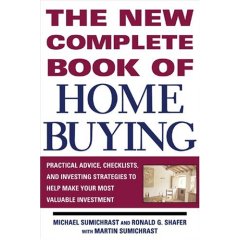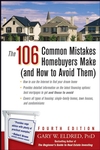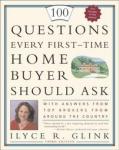|
|
To buy a home you need both
up-front money as well as the ability to make monthly mortgage payments.
You therefore might be tempted to ask, "How much will I need in order to make
the monthly payments?" But actually we'll approach this question from the other
direction: We'll find out the most expensive house you can buy given your income
and savings. This is called how much home you can afford. You won't
necessarily buy the most expensive home you can afford, but you still want to
know what your upper limit is. You don't want to waste your time looking at
homes you can't afford, and you also don't want to pass up homes you thought
you couldn't afford but which might actually be within your reach.
Here's the super-quick rule of thumb:
Most people can afford a home that costs up to three times their annual
household income, if they can make a 20% down payment and have only a moderate
amount of other debt. If you have little to no debt and can put 20% down you can
probably buy a house worth up to four times your annual income.
Examples: If you make $30,000 a year and
have money for a down payment saved, you can probably buy a $90,000 home if you
have moderate debt (debt payments of <12% of your income), and a $120,000 home
if you have little or no debt. But of course, this is just a quick rule of thumb
and you'll want to get a more accurate figure. The rest of this page will help
you with that. Also, if you're income is small but you're sure you can make the
mortgage payments and you have excellent credits there may be other options for
you, which we'll get to later.
The first concept for figuring how much home
you can afford is pretty simple. Since you pay for your house with a
combination of a down payment and a bank loan, the total of both is the cost of
the home:
Down Payment
+
Biggest Loan You Can Get =
How Much Home You Can Afford
The down payment part of the equation. is easy to
figure -- this is the total of your savings that you're willing to put into your
house. (We'll cover down payments in more detail on the next page.) We assume
you have money for a down payment because if you don't then you probably can't
afford any home, since it's hard to get a loan with 0% down. You usually
need a bare minimum of 3% of the purchase price down, more typically 10% or
more.
The amount you can get from a lender is a little
trickier since it's based on many factors. Here's a calculator that will help
you with that.
Note a few important things about this:
Putting 20% or more down opens lots of doors.
When you can make a down payment this big you're almost certain to qualify for
some kind of loan. The bank will be willing to loan more money than
otherwise, and you won't have to pay for private mortgage insurance (PMI), which
in turn helps you afford even more home.
Debt holds you back. The more debt you
already have the less home you can buy. Decreasing your debt allows you to
afford a more expensive home, everything else being equal.
Consider a duplex or a house with a garage apartment. When you get a home
with a unit you can rent out, you can count the rent you'll receive as income.
This can allow you to buy a substantially more expensive home than otherwise --
which will be a much better investment.
30-year loans aren't always better. The
beauty of 30-year loans is that they let you afford more home, but the downside
is that you pay dearly for that benefit through a ton of extra interest -- it
takes you an extra decade and a half of payments to pay the loan off. That
doesn't mean you should avoid a 30-year loan if that's all you can get for the
house you want to buy, but if you wind up getting a 30-year loan then try to pay
it off in 15 years to save on the interest.
We've left out one important thing -- closing
costs. You'll need to either pay the closing costs from your savings
(lowering the amount you have available for a down payment), or qualify for a
loan that's a little larger than the house you want to buy, and have the closing
costs added to the loan (which is called "rolling the closing costs" into the
mortgage).
Types of Down Payment
Nobody pays cash for a house.
Instead, you make a small down payment (3-20% of the sale price) and get
a bank loan for the rest. On a $140,000 house, you'll put down $4,200-$28,000.
The size of the down payment you have to make
depends on how good your credit is, and on what kind of loan you get. So
let's take a look at the three main kinds of loans: Conventional, FHA,
and VA:
Conventional.
The bank will expect you to put at least 10% down, and as much as 20%, or
as little as 5% if you're lucky. You might be able to get 0% down if you have
near-perfect credit and a significantly higher income than necessary to get a
regular loan.
FHA.
If you're a first-time home buyer, you might qualify for an
FHA loan, and put only
3-5% down. The loan is still made by the bank, not FHA. FHA just guarantees part
of the loan. That means they pay the bank if you fail to make your mortgage
payments. Don't get excited about that part of it, though -- if you fail to make
your mortgage payments the bank will still take the house back. The benefit of
the loan being partially guaranteed is that it's easier to get the loan, because
the bank doesn't take on much risk by loaning you the money if the FHA is
guaranteeing part of the loan. Another benefit of FHA loans is that they're
easier to get than conventional loans if you have credit problems. However, not
all sellers will agree to an FHA loan, because there's a little more red tape
involved, and because the house can't be a fixer-upper -- the house has to be in
excellent shape to pass an FHA inspection.
VA.
If you're a veteran, you might qualify for a VA loan and put nothing
down. Just like with FHA loans, the VA itself doesn't lend money, it just
guarantees part of the loan so lenders feel comfortable lending the money.
Qualified veterans can get loans up to $203,000 with no down payment.
VA-guaranteed loans can be combined with second mortgages (which is when the
bank makes the main loan covering most of the price of the house, and the seller
makes a separate loan to the buyer for the rest of the price.) VA loans can be
assumed by any future qualified buyer. (visit the
VA's home loan site
for more)
Right now you should figure out how much money
you have saved up that you can use for a down payment, unless you know you can
get a VA loan with no down payment.
back to top
Tip #3a: Don't
plan on borrowing the down payment. The down payment has
to be YOUR money. Why? Because when the bank gives you the
main loan on your house, they've calculated that you won't
be able to pay back your loan if you take on additional
debt, and borrowing the down payment is additional debt.
Also, if you don't make your payments and they have to
repossess the house and sell it, they'll often want to sell
it for less than it's worth so they can sell quickly, and
your down payment prevents them from having a loss if they
do that.
But what if someone gives you the money for a down
payment (your parents, maybe). That's okay as long as you
get an
FHA loan, but not if you get a conventional loan.
(Realize though that many sellers won't agree to an FHA loan
because it sometimes adds a little red tape and because the
inspectors are more strict about the condition the house has
to be in before it can be sold.)
Tip #3b: Pros of
bigger down payments.
- The more you put down, the bigger loan you can get
from a bank. For example, if you put only 5% down, a
bank might want to lend you up to $65,000. But if you
put 10% or 20% down, the bank might be willing to loan
you up to $78,000 or $100,000, respectively.
- For a given house price, the more you put down, the
easier it is to qualify for the loan.
- If you put 20% or more down, you won't have to buy
Private Mortgage Insurance (PMI).
Tip #3c: Cons of
bigger down payments.
- Every dollar you put into your down payment is a
dollar that you can't save or invest in something else.
Sure, your house is an investment, but you're often
better off taking the difference between, say, a 5% and
a 10% down payment, and putting it into a socially
responsible mutual fund instead. The mutual fund will
often give you a higher rate of return. It depends on
the economy. During the boom years of the Clinton
administration it would have been better to put your
free cash in stocks. Today, it would be better to put your free
cash into your house.
- Extra money you invest into your house via a bigger
down payment is harder to get out of your house
if you ever need the money for an emergency. (You'd have
to get a home equity loan, whereas with a mutual fund
you could simply sell your shares and convert them to
cash.)
Tip #3d: Don't pay
cash. Even if you can afford to pay cash for the house
without getting a loan, don't.
Tip #3e: Decide
whether to use your cash to pay down your debt or use it for
the down payment. A common question among homebuyers is,
"Should I use my extra cash to pay down my credit card debt,
or should I save it all for the down payment?"
|
|
Basics
The loan you get from the bank is called a mortgage,
also called a note. (We'll talk more about how to get
a loan in a minute.)
The bank loaning the money is the lender. The
amount you pay to the bank each month is your mortgage
payment. The rate of interest on the loan is the
mortgage rate (or the interest rate).
If you don't make your mortgage payments then the bank
will repossess the house. Then they'll sell it to make sure
that they can recoup the money they loaned to you, and that
you didn't pay back.
The number of years it takes to pay back the loan is
called the term, which is either 15 or 30 years.
There are pros and cons of each:
| 15-year mortgage |
. |
. |
30-year mortgage |
• Saves a bundle on interest
• Pay off the loan in half the time |
|
|
• Easier to qualify for
• Lower monthly payments
• Allows you to buy a higher-priced home |
The fact that you get lower payments with a 30-year
loan is deceptive -- your payments are lower but you
have to make those payments for twice as long, so you wind
up paying a lot more than with a 15-year loan. The
brief advice is:
Tip #3a:Get a
15-year loan if you can qualify for it, because you save
a bundle on interest and pay the loan off in half the
time. If the bank won't give you a 15-year loan,
then get a 30-year loan and pay it off early (in 15
years) if you can.
Paying back a mortgage
You pay back your loan by making a payment every month.
They don't send you a bill, so it's your responsibility to
remember to make the payments every month. They do give you
a cute little coupon book, with one slip for each month, so
you can include the slip when sending in your check each
month.
Part of your payment goes towards the principal
(the amount the bank loaned you), and part of it is
interest (the bank's profit from lending you money). So
when the bank loans you $100,000 you pay them back that
$100,000 and then some. If you only had to pay back the same
$100,000 they gave you then what would be in it for them?
That's why they charge interest.
Even though part of your monthly payment is for
principal and part is for interest, you write only a single
check to the bank each month, and that payment amount stays
the same for the life of the loan. You don't have to
know how much of your payment is for principal and how much
is for interest, but it's usually printed on the coupon, as
well as in an end-of-the-year statement the bank will send
you for your taxes, since you'll get to deduct the interest
you paid if you itemize.
Maybe you remember percentages from high school, so
you figure that if you have a $100,000 loan at 9% you'll be
paying the bank back $109,000? Nice try, but that's
simple interest, and banks don't work that way. But all
you really need to know for now is:
- You'll be paying the bank a lot more than
just simple interest.
- Just a percentage point or two of interest rates
means you'll be paying a lot of extra interest to
the bank.
Here are some pretty pictures to tell that story.
We'll assume a $125,000 loan for 30 years at various
interest rates.
Total Interest
Paid Over the Life of the Loan
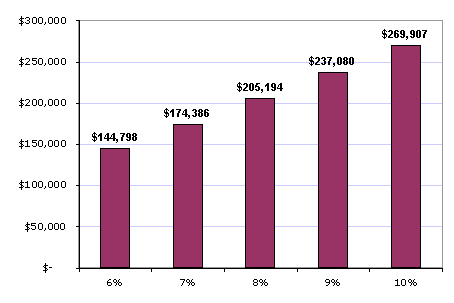
So even at a very low interest rate of 6%, you're
paying $145,000 in interest on a $125,000 loan. So you
borrow $125,000 and pay back $270,000 -- more than double
what you borrowed!
It's even worse if you have a higher interest rate.
Note how going from a 6% to 10% interest rate means you pay
an extra $125,000 over the life of the loan. So
the total you'd pay on a $125,000 loan at 10% would be
$125,000 principal + $269,907 interest = $394,907! Quite a
lot to pay back for a $125,000 loan, huh?
back to top
Average
Yearly Interest ($125,000 loan, 30 years)
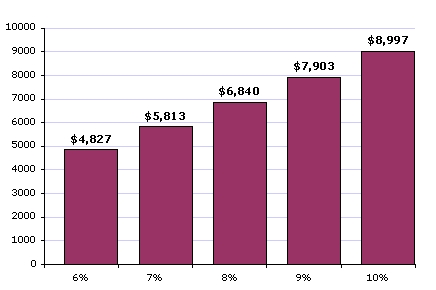
Here again, going from
6% to 10% interest means you pay an extra $5000 on average
in interest each year!
How the interest rate
affects the monthly payment
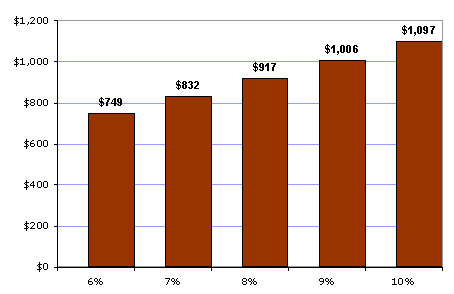
Owner
Financing
You might be thinking,
"Hey, could I just make payments directly to the seller
instead of getting a mortgage? Then I wouldn't have to
qualify for the mortgage." That indeed could be a good
deal, except that owner-financed deals like this are rare,
and are available only when the seller is unusually
desperate, generous, or stupid.
Put yourself in the
seller's shoes for a minute:
You own a $150,000 house,
and you've got $110,000 left on the mortgage. If you sell it
the regular way, you'll wind up with $40,000 in cash.
(You'll get $150k from the buyer -- part down payment, part
mortgage from the buyer's bank -- of which $110k will go
towards paying off your existing mortgage before you even
see the money.) You could do a lot with that $40k: make a
down payment on an even bigger house, travel the world, add
it to your nest egg to retire, go to Vegas, etc.
But let's say you
owner-finance the sale instead, in which you get a down
payment from the buyer, and let him/her make payments to you
for 15-30 years. First off, you won't be getting as much
money up front -- $15k on a 10% down, or $30k on a 20% down.
Second, you'd have to pay off the existing mortgage
before you could sell it! So you'd have to pay your bank
$110k in cash, before you get the measly $30k down payment.
But what if you own your
house free and clear? That is, what if you've already paid
off your 15- or 30-year mortgage so you didn't have to worry
about coughing up a lot of money to pay off the loan all at
once? Then in that case, you don't get your $150k all at
once -- you have to accept the small payments that trickle
in month after month from the buyer.
Why on earth would you do
this? Well, probably, you wouldn't, unless you're really
desperate to sell for some reason, or you don't understand
what a rotten deal it is for you, or you're unusually
generous.
So you see, it's not in
the seller's interest to finance the house for you, which is
why you'll rarely find houses that are owner-financed.
But there are a couple of
cases in which owner-financing might be a possibility for
you:
You offer a higher
interest rate. The reason that owners don't like to
finance is that there's nothing in it for them. So you have
to make sure there is something in it for them. One
way to do this is to offer to pay a higher interest rate. Of
course, you wouldn't make such an offer if you're able to
qualify for a bank loan, but if you can't get a bank
loan, then offering a higher rate directly to the seller
might be what it takes to get you into the home you want.
Also, once you've had the home for a year or two and your
financial situation improves you might be able to move that
loan to a bank.
Get the seller to
finance part of the loan. Once I wanted to buy a
home but I couldn't come up with the last $36,000. (I had no
more cash left and couldn't get a bigger loan.) But I really
wanted the house. So I asked the owner to owner-finance just
that small part of the cost of the house, and I offered him
twice the prevailing interest rate. He accepted.
Qualifying for a Mortgage Loan
Banks
don't loan money to just anybody.
They want to
feel secure that you're able and responsible enough to pay
them back. So you'll usually need these things in order for
the bank to give you a loan:
- Enough money for the Down Payment
(3 to 20% of the purchase price)
- Two years of steady employment
(same job or field)
- Good (not perfect) credit history
- Income that's 2 to 3 times higher
than your expected mortgage payment
|
|
back to top
If you don't have all
these things right now don't fret.
You still have
some options.
- Meet with a lender anyway.
Don't just assume you can't get a
mortgage. It can't hurt to go talk to a
bank and see whether they're willing to
give you a loan. Even if they won't give
you a loan they can probably help you by
letting you know where the deficiencies
are, so you can work towards qualifying
in the future.
- Try for a Low-Doc or No-Doc Loan.
In recent years banks have been offering
loans to people who can't (or don't want
to) provide details about their
employment or their income.
Naturally, you're expected to pay more
if the bank is taking a bigger risk on
you, so interest rates for Low-Doc and
No-Doc loans are often 0.25 to 3.0
percentage points higher than
traditional loans.
Here's how the different loans stack up.
|
What you need for each kind of loan
|
| |
Regular
Loan |
Low-Doc
("No Ratio") |
No-Doc
("NINA") |
| Down
Payment Needed |
♥
Smallest |
♥♥
Bigger |
♥♥♥
Biggest |
| Credit
Required |
♥
Good |
♥♥
Excellent |
♥♥♥
Near-Perfect |
| Employment
History |
♥
|
|
|
| Proof of
Income |
♥
|
|
|
| Proof of
Assets |
|
♥
|
Possible |
| Interest
Rate |
♥
Lowest |
♥♥
Higher |
♥♥♥
Highest |
|
|
- Get a co-signor. See if a
family member or very close friend with
a higher income and better credit than
yours will cosign a loan for you.
That means that the loan will be yours
and you'll be responsible for paying it,
but if you don't, the cosignor will have
to pay it. Obviously the cosignor will
have to have agreat deal of trust in you
for this option to work.
- Try to get a non-qualifying
assumption. Being able to assume a
loan is rare, but if you have no other
options then it might be worth looking
into.
- Try to get the owner to finance
all or part of the cost of the home.
Getting an owner to finance a home is
difficult, but if you have no other
options then it's worth a try. You can
increase your chances of success by
offering a higher interest rate and/or
asking the owner to finance only part of
the cost of the home.
- Use a Mortgage Broker. A
mortgage broker represents lots of
different lenders so they can shop
around to try to find one who will make
you a loan. They charge a fee for this
service but if you can't get a mortgage
otherwise then it could be worth it. You
can find mortgage brokers in the homes
section of the newspaper classifieds and
in the yellow pages. A good online
broker is
E-Loan.
- Plan for the future. Even if
you can't buy a home right this very
minute if you make home-owning a serious
goal then within two years you can
probably overcome most or all of any
obstacles above.
|
|
In addition to the down
payment, you'll also have to pay closing costs --
miscellaneous fees charged by those involved with the home
sale (such as your lender for processing the loan, the title
company for handling the paperwork, a surveyor, local
government offices for recording the deed, etc.). The amount
varies, but could be, say, $6000 on a $130,000 house. The
range is all over the map -- from 1 to 8% of the price of
the home, though more typically 2-3%. These costs are
significant -- especially after you've already had to come
up with a lot of cash for the down payment.
Your lender will give you
a more accurate estimate of closing costs on the purchase of
a particular house you've selected. (Don't ask me about
this, ask your lender.) This is called a "Good Faith
Estimate". If they don't give it to you, ask for it.
E-Loan has a good page
which summarizes
typical closing costs.
Tip: Make sure to get the Good Faith Estimate
from your Lender. Review it, and direct any questions
about it to your lender (not to me).
Tip: Roll in the closing costs into the
mortgage. If you don't have enough cash to pay the
closing costs, you can often get the closing costs added to
the amount of the loan. For example, if the loan amount is
for $150,000, and the closing costs are $4500, you'd add the
closing costs to the loan amount so you'd actually be
borrowing $154,500 total. This is handy if you're short on
cash after making your down payment.
You need two things to be
able to roll in your closing costs like this. First, you
have to qualify for the bigger loan. If the bank will only
loan you $150,000 from our earlier example and not a penny
more, then you've already hit the maximum they're willing to
loan. But don't get discouraged, because it's usually not a
problem to get the bank to loan you a few thousand extra
dollars extra.
The second thing is that
the new loan amount can't exceed what's called the
Loan-To-Value ratio (LTV), which is the amount of the
loan compared to the to the value of the house, based on the
appraisal. In simple terms, let's say the house is worth
$100,000, and the bank will loan up to a 95% LTV, meaning
they'll loan you up to $95,000. If your credit isn't so good
then the bank might only loan up to an 80% LTV, meaning
they'll loan you only $80,000.
Don't confuse the price
of the house with the value of the house. The bank
gets the value of the house -- what they think the
house is worth -- from the appraisal, which is a report
prepared by a professional which estimates the value of the
house. The selling price could be higher or lower than the
appraised value.
Okay, so the point of all
this is, if you roll the closing costs into the mortgage,
the new loan amount can't exceed your LTV. If the LTV amount
was $120,000, and the $4000 closing costs would push the
loan amount from $118,000 to $122,000, then the bank won't
let you roll in the closing costs. You could get around this
by making a larger down payment, so you don't have to borrow
as much money from the bank, but if you have the extra money
for the bigger down payment then you also have the extra
money to just pay that money towards the closing costs
instead of rolling them into the mortgage in the first
place.
One way of rolling the
closing costs into the mortgage is to have a seller
concession. It's a little complicated so I recommend you
just ask the lender if you can roll the closing costs into
the mortgage the easy way. The lender might require that you
use the seller concession method, though. If you have to go
that route, the way it works is that you and the seller say
that the sale price will be about 6% more than the price you
agreed on, and then the seller "gives" you that extra 6%
that you paid. For example, let's say the price was $100,000
and you're putting 10% down, or $10,000, so you're getting a
loan for $90,000. You and the seller decide to go the seller
concession route, so you agree that the price should be 6%
more, or $106,000. That means you'll now put $10,600 down
and get a loan for $95,400. See what happened? You got a
loan for $5,400 more than the original loan. That's what you
use to pay the closing costs. The seller doesn't keep the
extra money because part of the deal is that (s)he gives
that extra money back to you at closing.
Tip: Ask the seller to pay some of the closing
costs. If you're short on cash for the closing costs and
can't roll the closing costs into the mortgage, ask the
seller if they're willing to pay part of the closing costs.
It's not unusual for buyers to ask for this. Usually the
worst that can happen is that they say no.
Tip: Get the lender to pay the closing costs.
If you're short on cash for the closing costs and can't
roll the closing costs into the mortgage, some lenders will
pay part or all of the closing costs, but in exchange you'll
have to pay a higher interest rate on the loan, perhaps
0.25% or 0.50% higher. Ask your lender if this is an option
if you need it.
back to top
|
|
|
|

Services are
held at:
Spirit of Life
423 N. La Brea Ave.
Inglewood, CA. 90302
Get Directions

|
